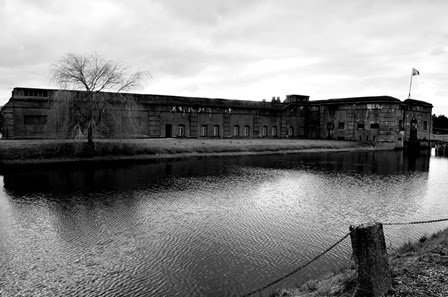 Na semana passada tive a oportunidade de visitar um campo de concentração e um museu sobre o antissemitismo com a minha escola Belga.
Na semana passada tive a oportunidade de visitar um campo de concentração e um museu sobre o antissemitismo com a minha escola Belga.Ao atravessar uma estrada cercada com arame farpado, eu sabia que estávamos chegando. Aquela construção cinza parecia transparecer todo o sofrimento de seus antigos prisioneiros, e dentro de cada sala havia uma história de horror diferente a ser contada. Toda aquela injustiça estava lá, bem na frente dos meus olhos. Antes dessa visita, confesso que era difícil acreditar que tanta crueldade realmente aconteceu.
Breendonk foi um campo de trabalho usado para prender, principalmente, inimigos do regime nazista (intelectuais). As pessoas ficavam ali até atingir um número em torno de 1.000 pessoas, que então seriam enviadas para Auschwitz, para extermínio.
Como era um campo pequeno, havia quase um nazista por prisioneiro, o que tornava as coisas ainda piores: tudo era vigiado. As torturas eram feitas durante a noite para que todos pudessem ouvir os gritos. A comida era escassa e as condições de higiene eram horríveis. Algumas pessoas morreram de doenças estomacais por comer coisas encontradas no campo. Essa foi a vida levada por milhares de pessoas durante anos.
 "Você vê essas coisas nos filmes, você vê nos noticiários. Mas você foi de uma época em que o seu país não esteve em guerra. Parecia irreal. De repente, lá está você, bem no meio dela, as pessoas estão morrendo e você está assustado, fora do juízo, com medo de ter a cabeça arrancada".
"Você vê essas coisas nos filmes, você vê nos noticiários. Mas você foi de uma época em que o seu país não esteve em guerra. Parecia irreal. De repente, lá está você, bem no meio dela, as pessoas estão morrendo e você está assustado, fora do juízo, com medo de ter a cabeça arrancada".PS: Mais algumas fotos no fim
-
Last week I had the chance of visiting a field of concentration and a museum about the anti-Semitism with my Belgian school.
While going
through a road surrounded with barbed wire I knew we were arriving. That gray
construction seemed to show all the suffering of its ancient prisoners, and
inside every single room there was a different horror story to be told. All
that injustice was there just in front of my eyes. Before really seeing it, it
was hard to believe such cruelty did happen.
Breendonk
is a working field, they used it to arrest, mostly, enemies of the regime
(intelectuals). People stood there until they had a number around 1.000 persons
to be sent to Auschwitz for extermination.
As it was a
small field, there was almost one Nazi by prisoner, what made things even worse:
everything was watched. Tortures were made during the night, so everybody could
hear the screams. The food was scarce and hygiene’s conditions were really bad.
Some people died of stomach disease for eating what they found on the field.
This was what life was about for thousands of people during years.
 "You saw those things in the movies, you saw the newsreels. But you were of an age when your country wasn't even in the war. It seemed unreal. All of a sudden, there you were right in the thick of it and people were dying and you were scared out of your wits that you'd have your head blown off."
"You saw those things in the movies, you saw the newsreels. But you were of an age when your country wasn't even in the war. It seemed unreal. All of a sudden, there you were right in the thick of it and people were dying and you were scared out of your wits that you'd have your head blown off." (Robert Rasmus)






Nenhum comentário:
Postar um comentário